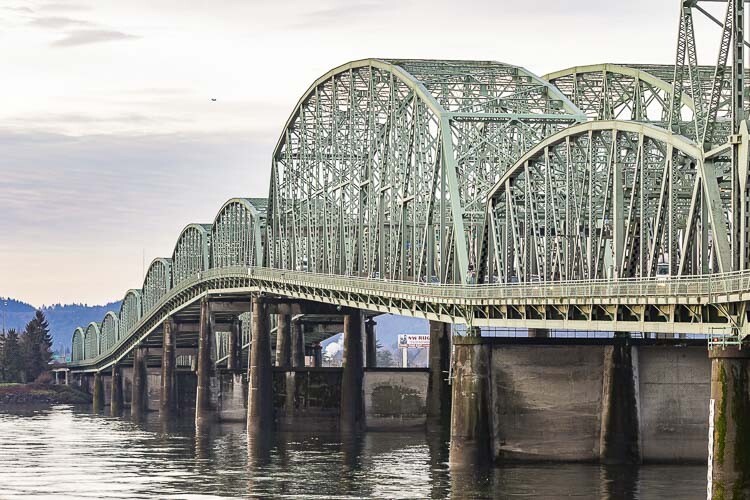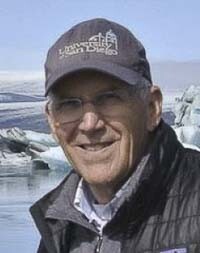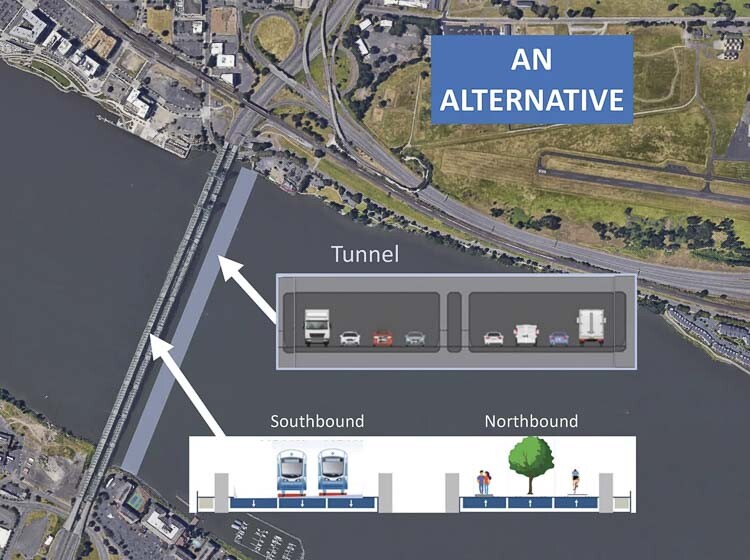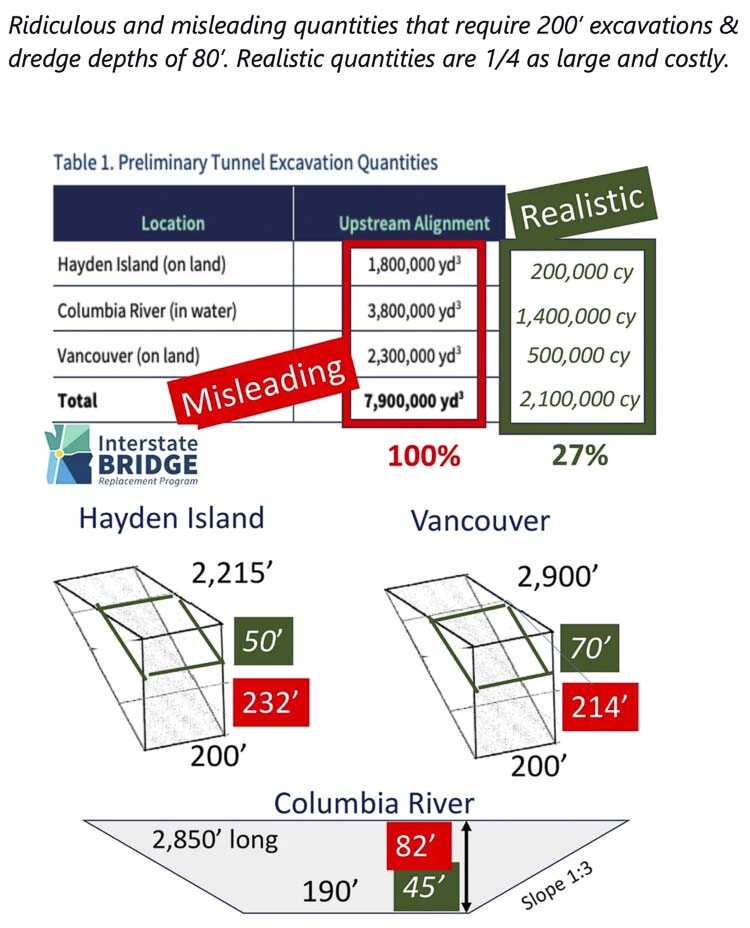
Retired Engineer Bob Ortblad believes a new study of an immersed tunnel by a consultant independent of the IBR must be done
Bob Ortblad MSCE, MBA
The Interstate Bridge Replacement Program (IBR) is the most expensive Washington highway project ever proposed, estimated to cost $5 to $7.5 billion. However, the IBR is risking $2.5 billion in essential Federal funding. IBR’s incompetence and deception will not go unnoticed by the Federal Highway Administration, U.S. Coast Guard, and U.S. Army Corps of Engineers.

Unfortunately, $300 million has been wasted promoting a dangerous bridge design to replace the Columbia River I-5 Bridge. A decade ago, the failed Columbia River Crossing (CRC) wasted $200 million and in the last three years the IBR has wasted an additional $100 million resurrecting the CRC’s failure.
The CRC/IBR bridge design is too dangerous. Two years ago, Antonio Lopez was killed by bad engineering. His SUV hit an icy curve on the I-205 Bridge and plunged into the Columbia River. The IBR’s bridge design will be steeper with a -4% downgrade, have a sharper S Curve, and an icy north-facing slope that will make it more lethal than the I-205 Bridge. Building this bridge would be more than engineering incompetence, it would be criminal.
The IBR intentionally disqualified a safer immersed tunnel alternative. A safer immersed tunnel will also reduce noise and pollution on Hayden Island, Vancouver, and Fort Vancouver. A tunnel will allow waterfront parks, can be built in half the time, and have less impact on salmon during and after construction. A tunnel will also enable the repurposing of the current southbound bridge for transit and a repurposed northbound bridge for walkers and bikers that would be a popular civil attraction.

Two years ago, on July 17, 2021, when the IBR team presented their “Tunnel Concept Assessment,” I challenged the inflated estimate of excavation and dredging. Program Administrator Greg Johnson assured me that WSP/USA consultants were experts and had done their research. Thirteen professional engineers and four consultants signed the report. With no professional engineer’s stamp, this unofficial report was used to disqualify an immersed tunnel alternative to the public and government officials. The legality of the report was challenged, and the IBR finally had the report stamped on April 19, 2023, by a professional engineer, twenty-one months after it was issued.
Last month, from a Public Disclosure Request, I obtained the IBR’s excavation and dredging calculations and drawings. My analysis confirmed my original doubts. The estimated 7.9 million cubic yards is wildly inflated. Every one of the 158 cross-section areas used to compute cubic yard volume is incorrect. A realistic estimate is 2.1 million cubic yards. This massive error of 6 million cubic yards can only be explained by intentional deception. Confronted with this error, after three weeks, the IBR pleaded incompetence. The IBR claims data was duplicated, and problems with third-party software, and quantity errors are common. The IBR just issued Revision 2 of its “Tunnel Concept Assessment” admitting its quantity estimate of 8 million cubic yards is 4 million cubic yards too large. An estimate error of over 6 million cubic yards is closer to the truth. The IBR surreptitious release of Revision 2 should be shared with local, state, and federal agencies that made decisions on this report. The IBR claims infallibility and refuses to retract this report.

Local political leaders rushing to grab Federal funds may ignore IBR’s deceit. The cities and ports of Vancouver and Portland plus C-TRAN, TriMet, Oregon Metro, and SW Washington Regional Transportation Council have all approved IBR’s bridge, the only alternative offered. The IBR has told them there is fierce competition for Federal funds. A Supplemental EIS requires evaluation of alternatives. The IBR is offering a single dangerous bridge alternative and ignores a safer immersed tunnel alternative, risking the loss of Federal funding. The Environmental Protection Agency will never approve the IBR single alternative-bridge Supplemental EIS and the IBR will lose $2.5 billion of Federal funding.
The IBR must retract this report and notify the public and government agencies that relied on it. WSP/USA must refund its consulting fee. A new study of an immersed tunnel by a consultant independent of the IBR must be done. An immersed tunnel alternative must be included in the IBR’s Supplemental EIS.
Bob Ortblad is a retired Civil Engineer, MBA, and CPA. He taught the history of infrastructure at the University of Washington, presented “Who Built Seattle” at Seattle Town Hall, and has experienced the infrastructure of seventy countries. He has lived on Capitol Hill in Seattle for 40 years.
Also read:
- Delays expected on Northwest 99th Street during water quality project constructionClark County will begin construction in July to install a stormwater filter vault on NW 99th Street. Drivers can expect delays, but lanes will remain open during the work.
- POLL: What’s the biggest concern you have with the current I-5 Bridge replacement plan?As costs rise and Oregon’s funding fails, concerns mount over the current I-5 Bridge replacement plan. Clark County Today asks readers: what’s your biggest concern?
- Plan ahead for ramp closures on I-5 near Ridgefield, July 8-9Travelers on northbound I-5 near Ridgefield should prepare for ramp closures July 8–9 as WSDOT crews conduct final testing of new wrong-way driving detection systems. The closures affect exits 9 and 11, including the Gee Creek Rest Area.
- Oregon DOT director calls transportation funding bill failure ‘shocking,’ warns of layoffsODOT Director Kris Strickler warned staff that up to 700 layoffs are imminent after lawmakers failed to pass a transportation funding bill, deepening the agency’s $300 million shortfall.
- New crossing opens over SR 500 in VancouverWSDOT has opened a new pedestrian and bike bridge over SR 500 in Vancouver, restoring direct and ADA-accessible access for people walking, biking, or rolling.









